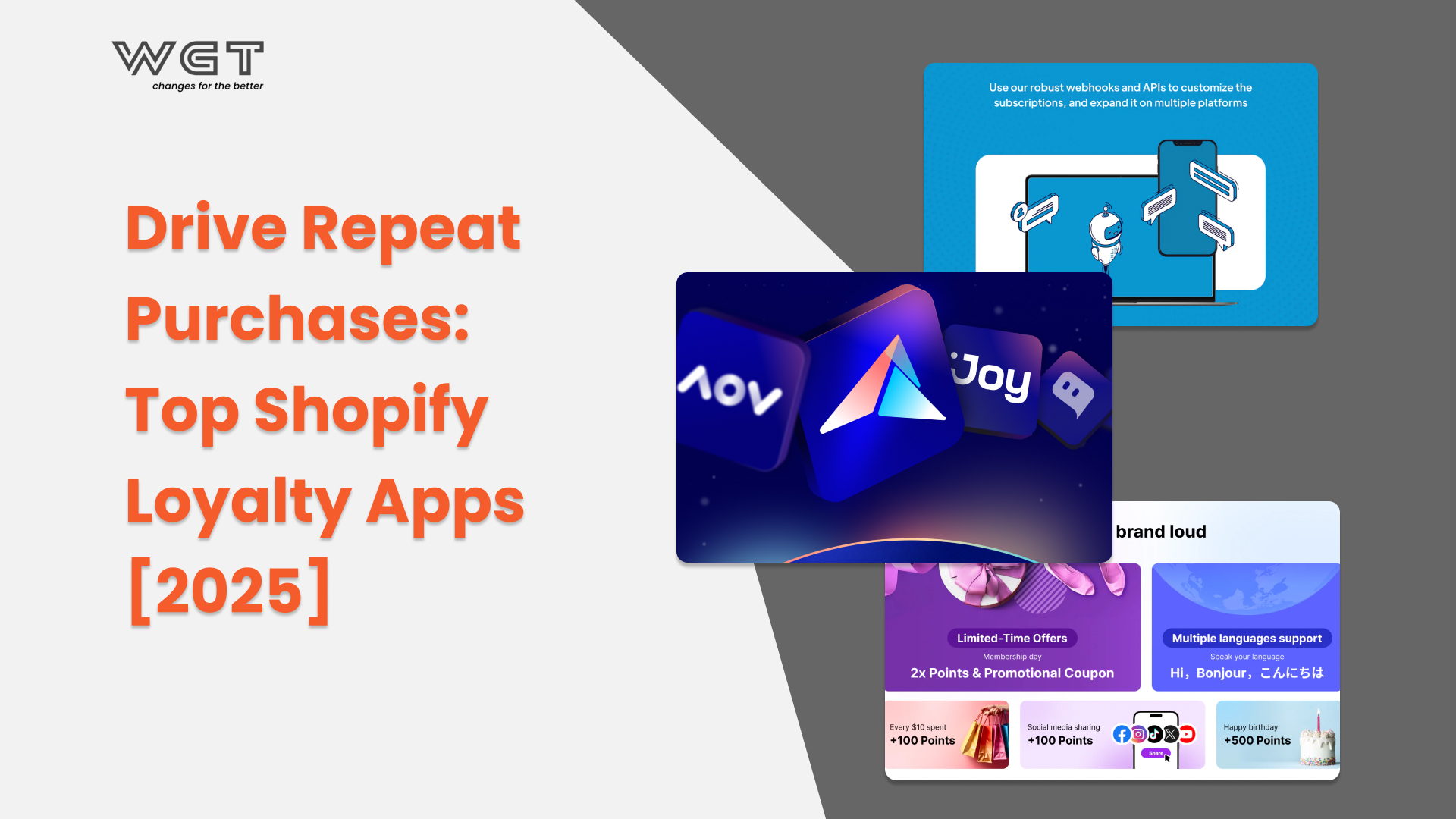
In the dynamic landscape of B2B e-commerce, where businesses navigate intricate structures and contend with diverse product catalogs, the role of Product Information Management (PIM) systems stands as a beacon of efficiency and reliability. Serving as a centralized hub for managing all aspects of product data, PIM systems streamline processes, ensure data accuracy, and pave the way for personalized customer experiences. This introduction delves into the critical importance of PIM in B2B e-commerce, highlighting its transformative impact on data management, customer engagement, and overall business success.
A. What is a Product Information Management (PIM) System?
Product Information Management (PIM) systems enable users to store, enhance, and oversee intricate product details. These tools centralize product-related data, simplifying the process of updating and maintaining accurate information across various sales and marketing channels.

Linked with the majority of eCommerce platforms, customer relationship management (CRM) systems, and enterprise resource management (ERP) software, PIM guarantees that up-to-date product information remains easily accessible across the entire organization. These tools are especially advantageous for eCommerce businesses with constantly changing product catalogs, evolving sales tactics, and varying marketing messages.
However, PIM systems are often conflated with other product-related software, such as master data management (MDM) tools, product experience management (PXM) solutions, product data management (PDM) platforms, and content management systems (CMS).
| MDM | PXM & PDM | CMS |
| MDM systems contain universal datasets like employee and supply chain information. | PXM concentrates on creating engaging customer experiences. PDM serves as an internal communication tool for engineers and product designers. | CMS software generally has lower capacity and handles more generalized content served for internal use or company websites. |
B. How does Product Information Management work?
- Gather
The PIM system retrieves content directly from merchant systems such as the ERP. It also enables uploading data, images and descriptions, either from XML or CSV files or directly from the supplier.
- Synchronize
Once uploaded into the product information management system, data will undergo cleansing and consolidation. For instance, duplicate items can be merged, categorized, and classified to ensure that information remains clean and standardized.
- Enrich
Within the platform, product content can be enriched by incorporating photos and videos or by optimizing existing content with SEO keywords. Furthermore, numerous PIM systems provide collaborative functionalities like customizable notifications, validation processes, and product statuses to ensure coherence among team members.
- Distribute
Sophisticated PIM systems seamlessly integrate with established enterprise systems such as supplier portals, vendor portals, ERP, CRM, and others. Data import and export from different business systems become easier and eliminate the possibility of error-prone entry of product data. By integrating PIM with other systems, merchants can keep all systems automatically updated with the latest data.
C. Important PIM features
When selecting a PIM system for merchant business, merchants should consider several key factors to ensure its suitability for merchant needs.
A worthwhile PIM system should encompass, at a minimum, some of the following features:
- Manual and automatic collection of product information.
- Capability to manage multiple SKUs.
- Customizable fields for item details such as product descriptions, attributes, sizes, etc.
- Ability to handle substitutions, replacement parts, and accessories.
- Automation of workflow processes.
- Management of content and marketing materials for each product.
- Integration with CMS, IMS, ERP, 3PL provider, and other components of the ecommerce ecosystem.
Customizable workflows tailored to various departments and segments of the supply chain.
In essence, if a business deals with a large variety of products or has a complex range of product types, adopting a PIM system is highly recommended. It will streamline manual data entry tasks and prevent confusion among different SKUs, especially during busy periods.
D. Benefits of implementing a PIM solution

- Reduce manual data entry
Product Information Management systems serve as a centralized hub for managing all aspects of product data, including descriptions, images, specifications, and pricing. Data is entered once and never reentered again, as product data is collected and managed by a PIM tool from business systems like ERP and eCommerce, and is quickly synchronized across platforms. This approach ensures consistency across all sales channels and eliminates data silos that can lead to errors and inconsistencies. For B2B enterprises grappling with complex business structures and large product catalogs, PIM solutions offer invaluable support by providing a framework for organizing and managing data effectively.
- Ensure accuracy and improved data quality
In the context of eCommerce evolution and the proliferation of sales channels, maintaining data integrity becomes increasingly challenging. B2B storefronts, in particular, often deal with a high volume of products and SKU counts, making manual data management unsustainable. PIM systems automate manual tasks and simplify the process of enriching product data, enabling teams to maintain accuracy and consistency across diverse channels.
Moreover, B2B product catalogs frequently involve complex data sets, including various versions, customization options, and extensive specification sheets. Ensuring consistency across these channels is paramount to avoid delays or errors in large bulk orders. PIM solutions play a crucial role in eradicating inaccuracies and inconsistencies, thereby enhancing product data quality and fostering trust among customers.
- Personalize customer experiences
Customer buying behaviors become more fluid and personalized, businesses must adapt to meet evolving expectations. PIM systems enable businesses to leverage extensive product data for fueling data-driven algorithms, leading to personalized recommendations and tailored experiences across different sales channels. This level of personalization is increasingly expected by B2B clients, with surveys indicating that personalized approaches significantly influence supplier selection decisions.
E. 03 Best PIM software for Shopify
1. Jasper PIM
All the essential product information is centralized by Jasper PIM into a robust system. On the customer-facing side, pictures, videos, and marketing materials of each product are stored, while supplier, inventory, and category data are stored behind the scenes.
Since it functions as a Shopify app, Jasper can be smoothly integrated into the platform, offering an enhanced experience for Shopify stores. This includes improved search capability and automatic product syndication to the merchant’s store.
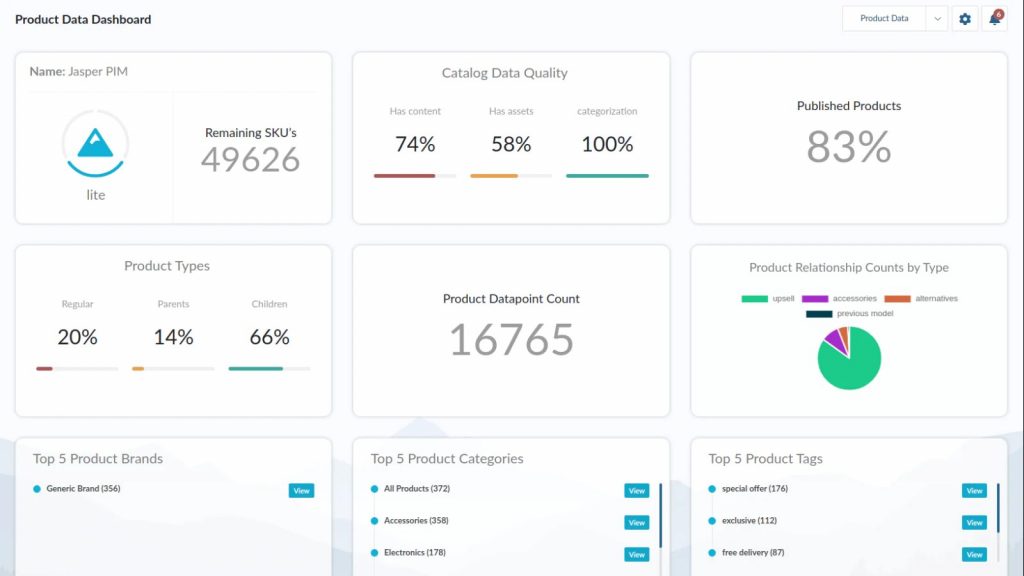
With Jasper, merchants could:
- Have the same products served through multiple brands and storefronts in different languages
- Have products syndicated automatically to e-commerce platforms
- Schedule updates to product content and promotional pricing
- Organize products alongside rich media content
Pricing starts from $999/month (at the time of publishing).
2. Plytix
Plytix is crafted with an emphasis on team collaboration, ensuring seamless access to accurate product information across various departments, including supply, logistics, sales, and marketing. With Plytix, confusion regarding product status and specifications becomes a thing of the past.
The Plytix team takes pride in their user experience (UX) and design, distinguishing their software from competitors with its visually appealing interface and user-friendly operation, characteristics not commonly found in backend e-commerce systems.
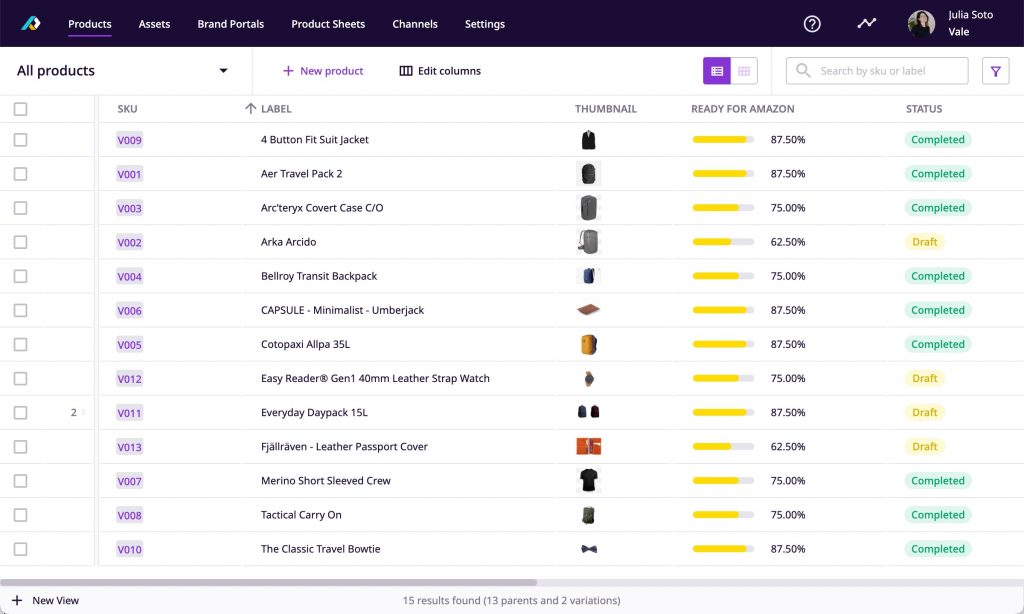
Key features of Plytix include:
- Unlimited user access
- Advanced filtering and search capabilities
- Management of digital assets
- API support for customized integrations
- Flexible management of product variations
Pricing options include a free plan, as well as paid options starting from $450/month for Standard and $1,650/month for Pro (at the time of publishing).

3. Sales Layer
Sales Layer is a cloud-based product information management system designed for product marketers. It is a user-friendly PIM platform, especially for enhancing the customer experience by delivering accurate content and data.
The PIM offered by Sales Layer places a notable focus on analytics: it can be utilized to analyze the quality of product information to ensure that the catalog is free from missing or incorrect data. Eventually, this capability can be highly beneficial for managing complex product ranges.
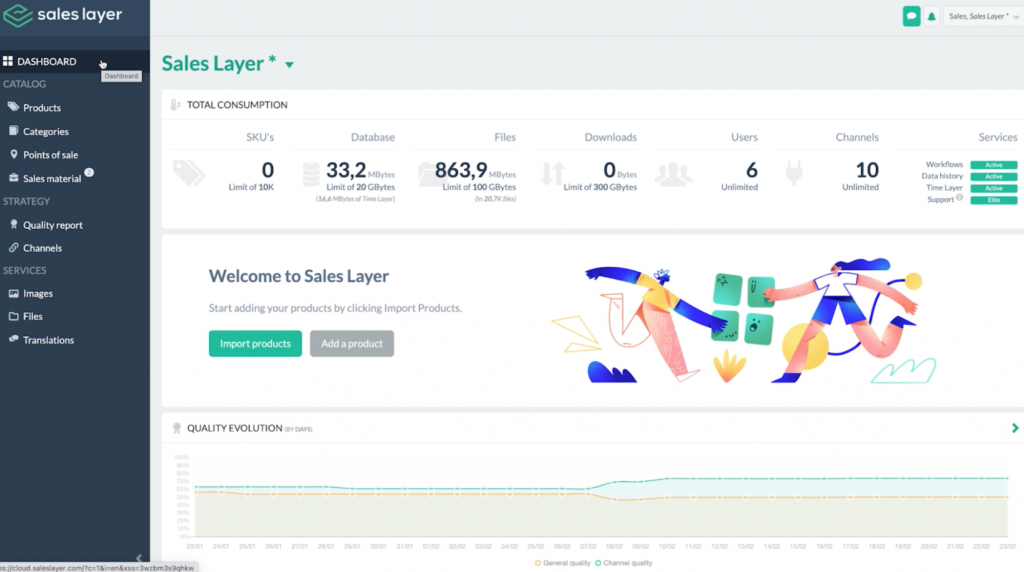
Features include:
- Real-time data updates
- Catalog status reports
- Management of digital assets
- Design and management of workflows
Price: Custom pricing is available upon request.
F. 03 Best PIM software for Magento
1. Akeneo Product Information Management
The Akeneo PIM Enterprise Edition is specifically designed to be user-friendly while offering robust enterprise-grade capabilities. Featuring advanced functionality accessible to all users not only oversees product information processes but also enhances them, regardless of catalog’s size. Thanks to the flexibility and extensive ecosystem of API-driven integrations, Akeneo PIM Enterprise Edition empowers merchant teams to create product experiences that yield tangible business results.

From a technical perspective, new tools have been introduced to tailor Akeneo to merchant-specific requirements:
- The APIs have been enhanced and expanded to accommodate a wide range of needs.
- The technical infrastructure is simplified, now utilizing a single storage solution: eliminating the need for separate MongoDB or MySQL storage configurations.
- New and improved tools have been introduced to facilitate API usage, including a dedicated API documentation website, our brand-new API PHP Client, and a Postman collection featuring our endpoints.
Price: Custom pricing is available upon request.
2. Pimcore Product Information Management
Tailored to meet specific business requirements, Pimcore offers an optimal solution, encompassing extensive enterprise features and robust support services. It is undoubtedly the optimal choice for any organization seeking to maximize the benefits of Pimcore.
While the Pimcore PaaS Edition provides a fast ramp-up with only a 10-minute setup and the best possible configuration options, Enterprise Edition allows for complete flexibility regarding customization, including managing it in merchant-preferred infrastructure.
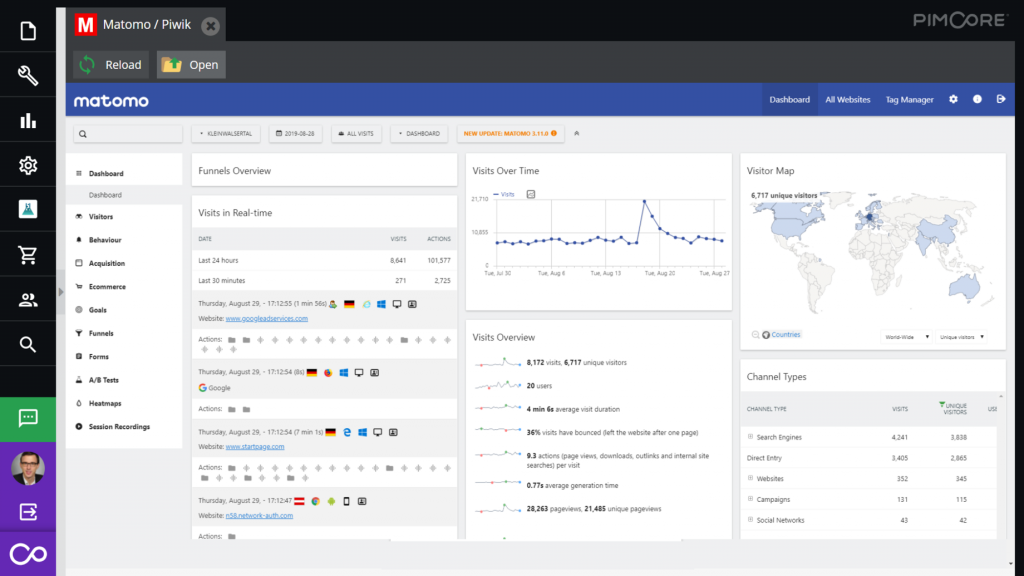
Pimcore includes:
- A secure solution or application based on Pimcore, safeguarding its source code.
- Total Cost of Ownership (TCO) reduction and Return on Investment (ROI) enhancement by providing access to security patches, legacy compatibility functionalities, and service level agreements.
- Full potential of the Pimcore Platform with optional expert consulting, strategic insights, industry best practices, comprehensive training, and tailored partner recommendations—all designed to elevate merchant business operations and objectives.
- Seamless experience, user-friendly interface featuring new submenus for the main navigation and editor toolbar, as well as a sleek Light Theme for enhanced usability and comfort.
Price: “Community Edition” is free forever, and the “Enterprise Edition” is available upon request.
3. Salsify Product Information Management
Salsify PIM isn’t just about managing product data — it’s about driving business growth. By providing excellent features such as workflow automation, integration with various e-commerce platforms, and actionable insights through advanced analytics, Salsify PIM brings out necessary tools such as Syndication, PXM Network, PXM App Center, Automation Workflow to outperform competitors and flourish in the ever-changing marketplace of today.
Price: Custom pricing is available upon request.
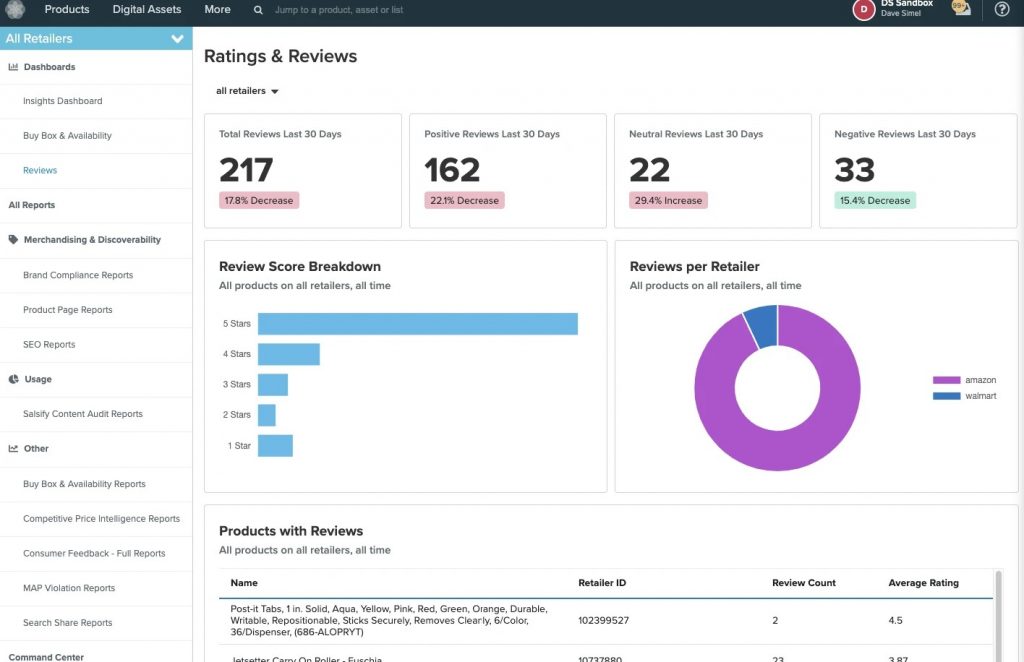
G. Conclusion
Effective Product Information Management (PIM) is a cornerstone of success in B2B eCommerce. By centralizing and optimizing product data, businesses can enhance customer experiences, drive sales, and stay ahead in the competitive marketplace. As technology continues to evolve, investing in robust PIM solutions will remain essential for B2B companies looking to thrive in the digital age. With the right approach to PIM, businesses can unlock new opportunities, build stronger relationships with customers, and achieve sustainable growth in the dynamic world of eCommerce.
Follow us to update more information about E-commerce hacks or news!!!








